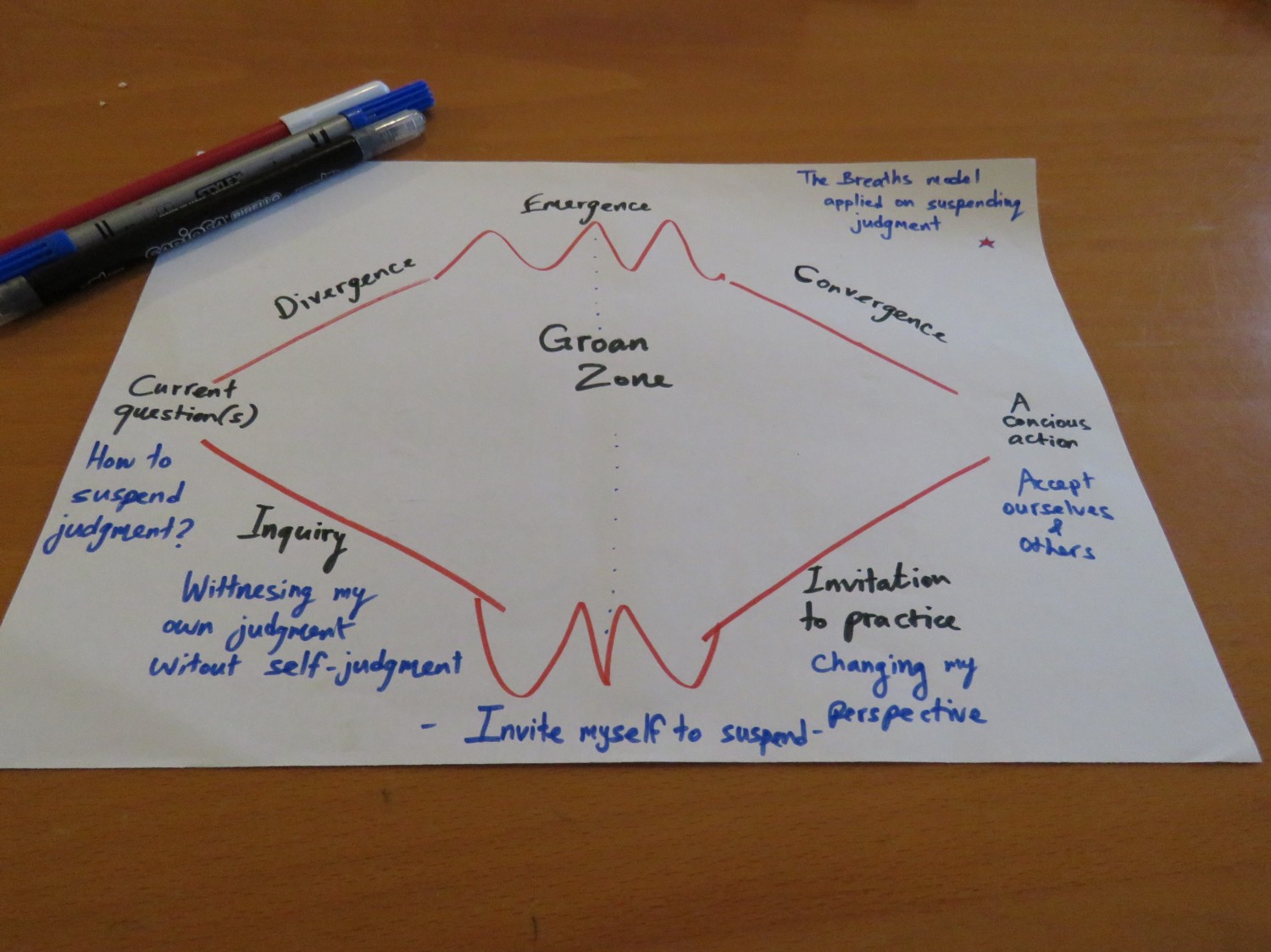Scared, worried, exhausted — that’s how I felt just half an hour before we started the session about judgment, as the final part of the Non-Violent Communication series I’m leading for parents in a Democratic school.
Earlier that week, when I assembled the session together, I decided to use a methodology called “eight breaths of design”, to demonstrate the process of suspending judgment. I had to modify it a bit. First, I used five breaths instead of eight (that kind of change has been done before) in order to match the model to the length of the process. Second, I shifted the focus from “design” into “moving from self-inquiry into conscious action”. Finally, I framed the steps of the process of suspending judgment within the different breaths — according to their progression.
Up until that point, it made sense to me; but as I was about to start preparing the space before the participants walked in, a disturbing thought arose: what if it only makes sense to me? What if I’m over-complicating things, instead of just going through the process with a simple and clear explanation? What am I trying to prove here?
I was scared that it won’t work, I was worried to lose the participants attention, and I was exhausted from over thinking whether I made the right decision.
And then it hit me: here I am, just a short time before delivering a session about suspending judgment, standing in this space and judging myself!
Once this awareness surfaced, I was able to suspend my own self-judgment, and recall the reason why I chose to match this content and method in the first place. It’s about experimenting and exploring, and there is nothing wrong with that. Even if I did make a mistake, even if no one listens, even if next time I choose differently — it was still worthwhile trying.
That story actually has a happy ending. The participants were fully co-operative, they’ve walked through the “breaths path” I drew on the floor and were greatly engaged in practicing the process. Some of them reported at the end of the evening that the session was highly meaningful for them. As for myself, relieved as I felt, it brought up new questions:
Why was I in a hurry to judge myself, especially when I’m supposed to be aware of this trap?
What is the mechanism that triggers my own judgment, and how can I become more prepared for the next time it will hit? (and it will!)

With judgment as a building block in the Non-Violent Communication approach (which I’m a strong advocate of), I decided to dive deep into understanding the judgment cycle and how to break it.
After reading Judgment Detox by Gabrielle Bernstein, as well as having conversations with friends, colleagues and workshop participants about the topic, I can better identify some of the causes which trigger judgment, to name a few:
- Fear
- Ego
- Projection of our own mistakes on others
- A defense mechanism for our imperfection
- An action or words which trigger our wounds or trauma
- Feelings like jealousy, frustration, disappointment and more
- A feeling of being misunderstood
In my situation prior to the session, some of those causes were definitely playing a role in provoking my self-judgment: I was afraid of making a mistake and I was worried I would be misunderstood by the participants and they would lose trust in me, therefore I judged myself for the decisions I took when designing the session. By realizing that, I am now able to examine how I can try to avoid a similar situation in the future, or at least to suspend my self-judgment in time.
Reflecting on the very same process of suspending judgment that I presented, it is becoming clearer what steps I should take when self inquiring my own judgmental thoughts:
- Witness my own judgment, without being harsh on myself. We all judge, that is only human. By illuminating the judgment once it appears, we’re able to understand our catalyst and track the cause that underpins a specific judgment. Maybe it is something we can already take care of — for example an unmet need we can address.
- Invite myself to pause and reflect on my patterns. This step should be taken in a very conscious way, with the intention to be as honest as I can with myself.
- Observe my thinking and my actions from a new angle. Embrace a more empathic perceptive about my own choices.
- Finally, practicing acceptance. Being able to accept my own mistakes, doubts and hesitations without self-judgment.
Suspending judgment and being able to accept others and ourselves without judgment is a continuous and consistent practice. We will probably never be able to evade judgment completely since it serves our ego so well… and as said, that’s perfectly human and natural. Yet with the right intention, commitment and practice to be aware of it — we are able to move forward with this process and pause, suspend, redirect our perspective and accept. Breaking the circle of judgment is possible if we just set our attention on it.
Interested to read more articles by Davida Ginter about accelerating change and social impact driven leadership? Please visit Be the Change
Originally published at medium.com


